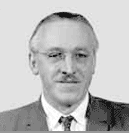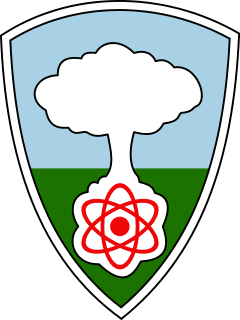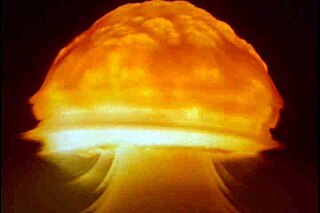Related Research Articles

The Partial Test Ban Treaty (PTBT) is the abbreviated name of the 1963 Treaty Banning Nuclear Weapon Tests in the Atmosphere, in Outer Space and Under Water, which prohibited all test detonations of nuclear weapons except for those conducted underground. It is also abbreviated as the Limited Test Ban Treaty (LTBT) and Nuclear Test Ban Treaty (NTBT), though the latter may also refer to the Comprehensive Nuclear-Test-Ban Treaty (CTBT), which succeeded the PTBT for ratifying parties.

Los Alamos National Laboratory is a United States Department of Energy national laboratory initially organized during World War II for the design of nuclear weapons as part of the Manhattan Project. It is a short distance northwest of Santa Fe, New Mexico, in the southwestern United States.

Lawrence Livermore National Laboratory (LLNL) is a federal research facility in Livermore, California, United States, founded by the University of California, Berkeley in 1952. Originally a branch of the Lawrence Berkeley National Laboratory, the Lawrence Livermore laboratory became autonomous in 1971 and was designated a national laboratory in 1981.

The Sandia National Laboratories (SNL), managed and operated by the National Technology and Engineering Solutions of Sandia, is one of three National Nuclear Security Administration research and development laboratories in the United States. Their primary mission is to develop, engineer, and test the non-nuclear components of nuclear weapons and high technology. Headquartered in Central New Mexico near the Sandia Mountains, on Kirtland Air Force Base in Albuquerque, Sandia also has a campus in Livermore, California, next to Lawrence Livermore National Laboratory, and a test facility in Waimea, Kauai, Hawaii.

Operation Nougat was a series of 44 nuclear tests conducted at the Nevada Test Site in 1961 and 1962, immediately after the Soviet Union abrogated a testing moratorium, with the US' Mink test shot taking place the day before the Soviets test-detonated the Tsar Bomba. Most tests were limited-yield underground test shots. New designs would be further developed in atmospheric testing during Operation Dominic I and II.
Sandia Base was the principal nuclear weapons installation of the United States Department of Defense from 1946 to 1971. It was located on the southeastern edge of Albuquerque, New Mexico. For 25 years, the top-secret Sandia Base and its subsidiary installation, Manzano Base, carried on the atomic weapons research, development, design, testing, and training commenced by the Manhattan Project during World War II. Fabrication, assembly, and storage of nuclear weapons was also done at Sandia Base. The base played a key role in the United States nuclear deterrence capability during the Cold War. In 1971 it was merged into Kirtland Air Force Base.

Kirtland Air Force Base is a United States Air Force base located in the southeast quadrant of the Albuquerque, New Mexico urban area, adjacent to the Albuquerque International Sunport. The base was named for the early Army aviator Col. Roy C. Kirtland. The military and the international airport share the same runways, making ABQ a joint civil-military airport.

The United States Department of Energy National Laboratories and Technology Centers are a system of facilities and laboratories overseen by the United States Department of Energy (DOE) for the purpose of advancing science and technology to fulfill the DOE mission. Sixteen of the seventeen DOE national laboratories are federally funded research and development centers administered, managed, operated and staffed by private-sector organizations under management and operating (M&O) contract with DOE.

Stockpile stewardship refers to the United States program of reliability testing and maintenance of its nuclear weapons without the use of nuclear testing.
A bhangmeter is a non-imaging radiometer installed on reconnaissance and navigation satellites to detect atmospheric nuclear detonations and determine the yield of the nuclear weapon. They are also installed on some armored fighting vehicles, in particular NBC reconnaissance vehicles, in order to help detect, localise and analyse tactical nuclear detonations. They are often used alongside pressure and sound sensors in this role in addition to standard radiation sensors. Some nuclear bunkers and military facilities may also be equipped with such sensors alongside seismic event detectors.

The Vela incident, also known as the South Atlantic Flash, was an unidentified double flash of light detected by an American Vela Hotel satellite on 22 September 1979 near the Prince Edward Islands in the Indian Ocean.

Jordan Carson Mark was a Canadian-American mathematician best known for his work on developing nuclear weapons for the United States at the Los Alamos National Laboratory. Mark joined the Manhattan Project in 1945, and continued to work at Los Alamos under the leadership of Norris Bradbury after World War II ended. He became the leader of the Theoretical Division at the laboratory in 1947, a position he held until 1973. He oversaw the development of new weapons, including the hydrogen bomb in the 1950s. On the hydrogen bomb project he was able to bring together experts like Edward Teller, Stanislaw Ulam and Marshall Holloway despite their personal differences.

The Mark 4 nuclear bomb was an American implosion-type nuclear bomb based on the earlier Mark 3 Fat Man design, used in the Trinity test and the bombing of Nagasaki. With the Mark 3 needing each individual component to be hand-assembled by only highly trained technicians under closely controlled conditions the purpose of the Mark 4 was to produce an atomic weapon as a practical piece of ordnance. The Mark 4 Mod 0 entered the stockpile starting March 19, 1949 and was in use until 1953. With over 500 units procured, the Mark 4 was the first mass-produced nuclear weapon.

The Air Force Nuclear Weapons Center (AFNWC) is a USAF Named Unit, assigned to the Air Force Materiel Command at Kirtland Air Force Base, New Mexico. The AFNWC operates at the Center level of the AFMC. It is currently under the command of Major General Shaun Q. Morris.

The Boeing NC-135 and NKC-135 are special versions of the Boeing C-135 Stratolifter and Boeing KC-135 Stratotanker modified to operate on several different programs.

The National Museum of Nuclear Science & History is a national repository of nuclear science information chartered by the 102nd United States Congress under Public Law 102-190, and located in Albuquerque, New Mexico. "The mission of the National Atomic Museum is to serve as America's resource for nuclear history and science. The Museum presents exhibits and quality educational programs that convey the diversity of individuals and events that shape the historical and technical context of the nuclear age."

The National Nuclear Security Administration (NNSA) is a United States federal agency responsible for safeguarding national security through the military application of nuclear science. NNSA maintains and enhances the safety, security, and effectiveness of the U.S. nuclear weapons stockpile without nuclear explosive testing; works to reduce the global danger from weapons of mass destruction; provides the United States Navy with safe and effective nuclear propulsion; and responds to nuclear and radiological emergencies in the United States and abroad.

The Armed Forces Special Weapons Project (AFSWP) was a United States military agency responsible for those aspects of nuclear weapons remaining under military control after the Manhattan Project was succeeded by the Atomic Energy Commission on 1 January 1947. These responsibilities included the maintenance, storage, surveillance, security and handling of nuclear weapons, as well as supporting nuclear testing. The AFSWP was a joint organization, staffed by the United States Army, United States Navy and United States Air Force; its chief was supported by deputies from the other two services. Major General Leslie R. Groves, the former head of the Manhattan Project, was its first chief.

Operation Dominic was a series of 31 nuclear test explosions with a 38.1 Mt (159 PJ) total yield conducted in 1962 by the United States in the Pacific. This test series was scheduled quickly, in order to respond in kind to the Soviet resumption of testing after the tacit 1958–1961 test moratorium. Most of these shots were conducted with free-fall bombs dropped from B-52 bomber aircraft. Twenty of these shots were to test new weapons designs; six to test weapons effects; and several shots to confirm the reliability of existing weapons. The Thor missile was also used to lift warheads into near-space to conduct high-altitude nuclear explosion tests; these shots were collectively called Operation Fishbowl.

All-Russian Scientific Research Institute Of Technical Physics (VNIITF) is a research institute based in Snezhinsk, Russia. It was previously also known as NII-1011.
References
- 1 2 3 4 5 "Readiness Program" (PDF). Sandia National Laboratories. Archived from the original (PDF) on 2006-09-27. Retrieved 2007-03-22.
- 1 2 Mulkin, Barb. "In Flight: The Story of Los Alamos Eclipse Missions" (PDF). Los Alamos Science . Los Alamos National Laboriatories. Retrieved 2007-03-22.
- ↑ Dolci, Wendy (1997). "Milestones in Airbornce Astronomy: From the 1920s to the Present" (PDF). American Institute of Aeronautics and Astronautics. Archived from the original (PDF) on 2006-09-05. Retrieved 2007-03-22.